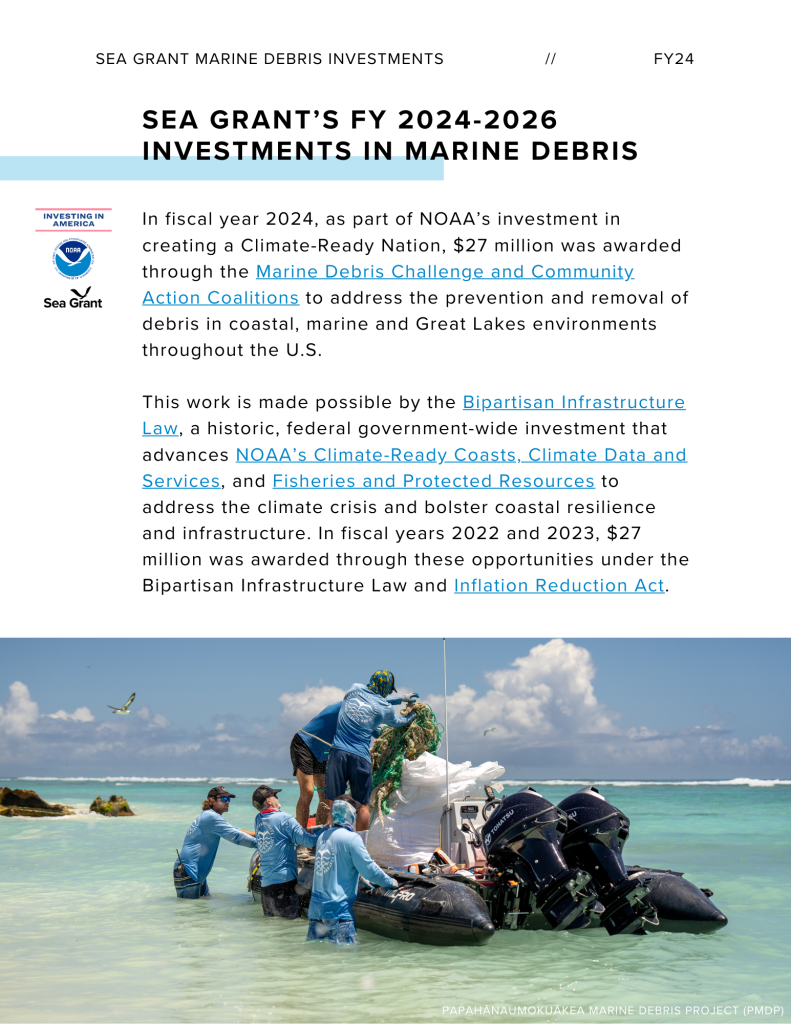Marine Debris
Sea Grant works closely with communities nationwide and in partnership with the NOAA Marine Debris Program to address marine debris challenges in marine, coastal and Great Lakes environments. Through research, extension and education, Sea Grant informs and enhances strategies to prevent the creation of marine debris and remove marine debris from the environment.
With funding through the Bipartisan Infrastructure Law and Inflation Reduction Act, Sea Grant has invested over $50 million in projects across the country to advance marine debris prevention and removal technologies and approaches, and to translate innovative research into practical results, and engage communities, groups and localities — particularly those that have been historically underserved — in translating research into collaborative marine debris removal and prevention efforts.

What is Marine Debris?
As one of the most widespread pollution problems facing the world’s ocean and waterways, our waters are filled with marine debris, items that do not belong in it. Marine debris includes any manufactured or processed solid material that is directly, indirectly, intentionally or unintentionally disposed of or abandoned in the marine environment or the Great Lakes.
How is marine debris harmful?
When marine debris is in our waters and on our shores, beaches and public recreation areas are impacted, affecting ecotourism and local economies. The Great Lakes economy relies heavily on tourism and recreation by maintaining healthy coastal resources while keeping the environment clean. Beach-goers and visitors can be impacted by marine debris as well as these items can cause physical bodily harm if found on shorelines or in the water. Human consumption of marine debris is also possible if small particles are accidentally ingested, however potential health risks from different plastics and chemicals are still unknown.

What can we do to mitigate the impacts of marine debris?
Being aware of how to properly dispose of fishing line and garbage can greatly reduce impacts to marine ecosystems. Beach cleanups are another great way to combat shoreline trash while collectively working together to reduce debris in public areas. Reducing reliability on single-use plastics can also greatly reduce the amount of marine debris entering our waterways and marine ecosystems. Read more about how to help at NOAA’s Marine Debris Program.
Funded Projects
Sea Grant has supported marine debris research for decades. In recent years, several projects have been competitively selected through opportunities supported by the Bipartisan Infrastructure Law and leveraging funds from the Inflation Reduction Act: The Marine Debris Challenge Competition and The Marine Debris Community Action Coalitions.
The Challenge Competition supports innovative, transformational research-to-application projects that will address the prevention and removal of marine debris, while the Community Action Coalitions support the creation of coalitions and partnerships to address marine debris prevention and removal. Learn more about these selected projects and other marine debris work below.
Sea Grant Marine Debris Symposium
Sea Grant’s Annual Marine Debris Symposium brings together grantees, researchers, community members, and other partners to share updates on Marine Debris Challenge and Community Action Coalitions Competition projects, discuss marine debris prevention and removal, and create a network of peer support for current and future work.
The 2024 Sea Grant Marine Debris Symposium will take place in person on November 12th-14th in Silver Spring, MD with options for virtual attendance. Stay tuned for more details, including speakers, session topics and registration information.
Watch the videos from previous meetings below to learn more about Sea Grant’s work in marine debris.
Marine Debris Impacts

Virginia Sea Grant extension helps address local abandoned and derelict vessels

Wisconsin Sea Grant commits to teaching the impacts of marine debris with a new teaching tool

USC Sea Grant shares sources of marine debris through an interactive StoryMap

Connecticut and New York Sea Grant release Long Island Sound Marine Debris Action Plan

Sea Grant’s commitment to cleaning local beaches and shores

Gulf Sea Grant programs remove abandoned crab traps from the environment
Marine Debris News

Connecting STEM to Student Roots: USC Sea Grant Intern Aids in Beach Cleanup Efforts
Daniela Loera, USC Sea Grant’s 2021 Community Engaged Intern, recently completed the summer internship with an emphasis on informing policy and engaging communities about their influence on beaches through beach

NOAA Sea Grant-Marine Debris Program partnership continues to address marine debris challenges with six new projects
NOAA Sea Grant and the NOAA Marine Debris Program announce the funding of six new, creative projects to tackle marine debris challenges across the country. This year’s projects focus on

Eight Sea Grant Programs Awarded Funds from Sea Grant-Marine Debris Special Projects Competition
Marine debris is a pervasive global problem that touches every corner of our ocean and Great Lakes. Sea Grant, in collaboration with the NOAA Marine Debris Program, recently awarded $350,000








